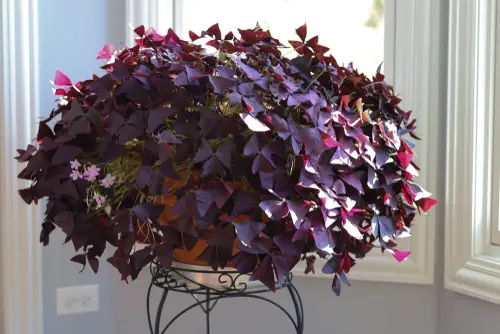Shamrock plants are a popular houseplant known for their vibrant green leaves and delicate white or pink flowers. However, sometimes these plants can start to droop, causing concern for their owners.
There are several reasons why a shamrock plant may start to droop, and it’s important to understand the causes and proper care techniques to keep these plants healthy.
One of the most common reasons for shamrock plant drooping is overwatering or underwatering. Shamrock plants require moist but well-drained soil, and overwatering can lead to root rot and drooping leaves.
On the other hand, underwatering can cause the leaves to wilt and droop as the plant struggles to retain moisture. Other factors that can cause drooping include lack of sunlight, poor soil drainage, pests, and disease. It’s important to diagnose the cause of the drooping leaves to determine the appropriate treatment.
Key Takeaways on Shamrock Plant Drooping
- Proper care is essential for keeping shamrock plants healthy and vibrant.
- Overwatering and underwatering are common causes of shamrock plant drooping.
- Other factors that can cause drooping include lack of sunlight, poor soil drainage, pests, and disease.
Also don’t miss:
- Why Is My Yucca Plant Drooping?
- Why Is My Swiss Cheese Plant Drooping?
- Rattlesnake Plant Leaves Drooping
Understanding Shamrock Plant

Shamrock plants, also known as wood sorrel, are a popular houseplant that belongs to the genus Oxalis. There are several species of shamrock plants, including Oxalis triangularis, Oxalis regnellii, Oxalis acetosella, and false shamrock.
These plants are known for their three-lobed leaves that resemble a clover and their delicate, funnel-shaped flowers that bloom in a range of colors, including pink, white, and yellow.
Shamrock plants are relatively easy to care for and can thrive in a variety of indoor environments. However, they can be prone to drooping, which can be caused by several factors.
Some of the most common reasons for drooping shamrock plants include overwatering, underwatering, lack of sunlight, sun scorch, poor soil drainage and quality, disease, pests, dormancy, lack of nutrients, and dust.
To care for a drooping shamrock plant, it’s essential to check the soil moisture level and adjust watering accordingly. If the soil is too wet, allow it to dry out before watering again.
If the soil is too dry, water the plant thoroughly and allow the excess water to drain away. Repotting may also be necessary if the soil is compacted or lacks nutrients.
Shamrock plants prefer bright, indirect light and should be placed near a window that receives morning or afternoon sunlight. If the plant is getting too much direct sunlight, it can lead to sun scorch and cause the leaves to droop. Additionally, it’s essential to provide the plant with well-draining soil that is rich in organic matter.
Shamrock Plant Drooping – 4 Common Problems
Shamrock plants are known for their beautiful foliage and vibrant colors. However, they can sometimes droop due to various reasons. Here are some common causes of shamrock plant drooping:
1. Overwatering and Underwatering
Overwatering or underwatering are common reasons for shamrock plant drooping. Too much water can lead to root rot, which can cause the plant to droop and wilt.
Conversely, too little water can cause the plant to dry out and droop. It is essential to ensure that the plant is watered correctly by checking the soil moisture level. The soil should be moist but not waterlogged.
2. Lack of Proper Light

Shamrock plants require adequate light to thrive. Insufficient light can cause the plant to droop and wilt. It is essential to place the plant in a location that receives bright, indirect light. If the plant is not getting enough light, it may be necessary to move it to a different location or use artificial light sources.
3. Temperature Fluctuations
Shamrock plants are sensitive to temperature fluctuations. Extreme temperatures, whether hot or cold, can cause the plant to droop and wilt. It is essential to keep the plant in a location with a consistent temperature and away from drafts.
4. Pest Attacks
Pests such as aphids and rust can attack shamrock plants, causing them to droop and wilt. It is essential to inspect the plant regularly for signs of pest infestations and take appropriate measures to control them. This may include using insecticides or natural remedies such as neem oil.
The Dormancy Period and Its Effects
Shamrock plants, like many other plants, have a natural dormancy period during which they slow down their growth and conserve energy. This period typically occurs in the fall, winter, and early spring months.
During this time, the plant’s leaves may begin to yellow and droop, which can be alarming for plant owners who are not aware of the plant’s natural growth cycle.
The dormancy period is a necessary part of a shamrock plant’s life cycle, and it is important to understand the effects it can have on the plant. One of the most noticeable effects is the drooping of the leaves, which is a sign that the plant is conserving energy.
As the plant prepares for its dormant period, it will slow down its growth and reduce its water and nutrient requirements. This can cause the leaves to droop and turn yellow as the plant conserves energy.
It is important to note that not all shamrock plants will go through a dormancy period at the same time. Some plants may begin to go dormant earlier or later than others, depending on a variety of factors such as light, temperature, and humidity levels.
This can make it difficult to determine whether a plant is simply going through a natural dormancy period or if there is an underlying issue that needs to be addressed.
During the dormancy period, it is important to reduce the amount of water and fertilizer that the plant receives. Overwatering or over-fertilizing the plant can cause damage to the roots and prevent the plant from entering its natural dormant state.
It is also important to avoid disturbing the plant during this time, as any stress or damage can prevent the plant from entering dormancy.
Proper Care for Shamrock Plants
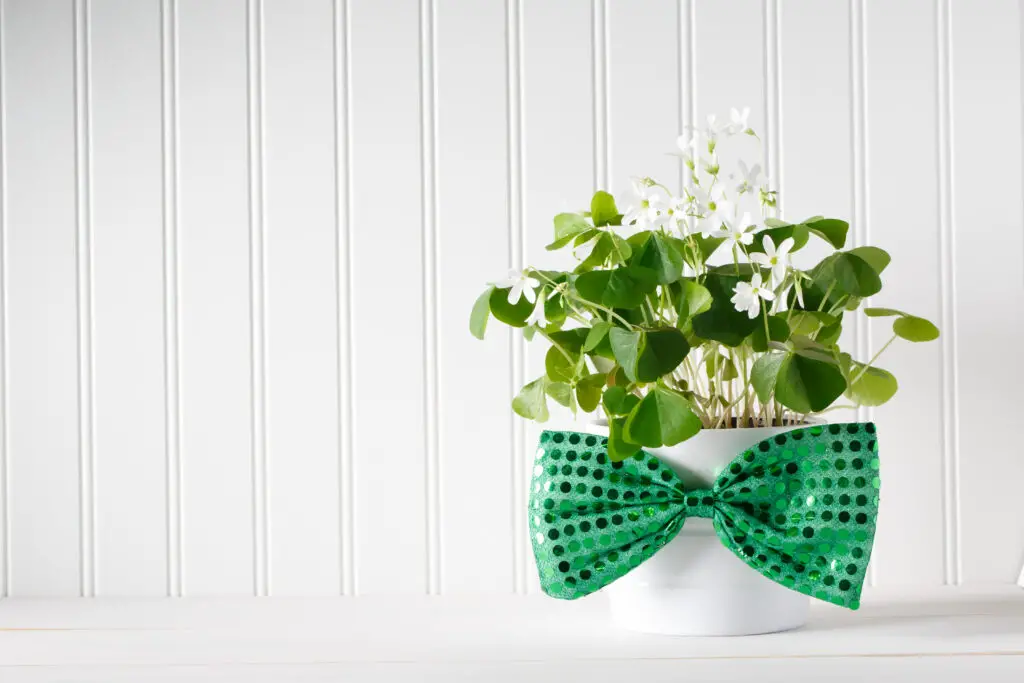
Shamrock plants are a popular indoor plant known for their vibrant green foliage and delicate flowers. Proper care is essential to keep them healthy and thriving. This section covers the essential care requirements for Shamrock plants.
1. Watering Schedule
Overwatering or underwatering can cause Shamrock plants to droop. Therefore, it is crucial to maintain a proper watering schedule. Shamrock plants prefer slightly moist soil, but they do not like to sit in water.
Water the plant when the top inch of soil feels dry to the touch. During the growing season, water the plant every 7-10 days. Reduce watering frequency during the dormant period.
2. Light and Temperature Requirements
Shamrock plants require bright light but not direct sunlight. Place the plant in a location that receives bright, indirect sunlight for at least 6 hours a day. Avoid placing the plant in a drafty location or near heating or cooling vents. Shamrock plants prefer temperatures between 60-75°F.
3. Soil and Repotting Requirements
Shamrock plants prefer well-drained soil. Use a potting mix that is rich in organic matter, such as compost or peat moss. Repot the plant every 1-2 years, or when it outgrows its current container. When repotting, choose a container that is one size larger than the current one.
4. Feeding and Fertilizer
Shamrock plants benefit from regular feeding during the growing season. Use a balanced, liquid fertilizer every 2-3 weeks. Dilute the fertilizer to half strength to avoid over-fertilizing. Reduce feeding frequency during the dormant period.
Shamrock Plant Varieties
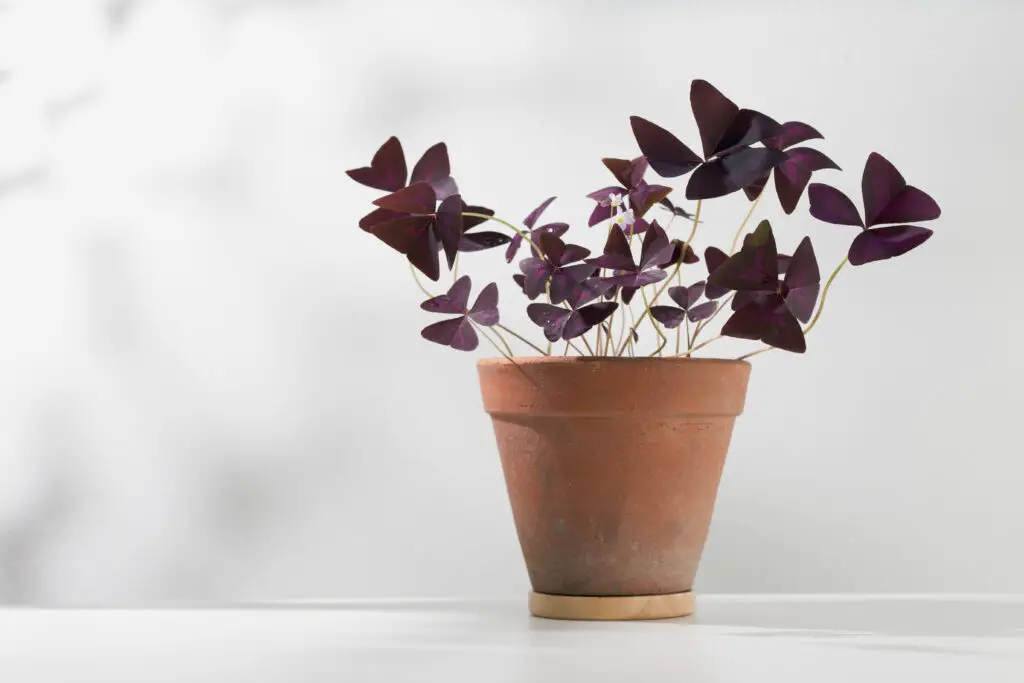
Shamrock plants come in different varieties, each with unique characteristics. Here are the three most common types of shamrock plants:
Green Shamrock
The green shamrock plant, also known as Oxalis acetosella, is the most common variety of shamrock. It has clover-like leaves that are green in color and usually have three leaflets.
This plant is native to Europe and North America and is often used as a ground cover in gardens. It is easy to care for and can thrive in both indoor and outdoor environments.
Purple Shamrock
The purple shamrock plant, also known as Oxalis triangularis, is a popular indoor plant. It has triangular-shaped leaves that are purple in color and can be up to 8 inches long. This plant is native to Brazil and is often grown for its attractive foliage. The purple shamrock plant is easy to care for and can be grown in a variety of soil types.
Red Shamrock
The red shamrock plant, also known as Oxalis regnellii, is a popular indoor plant that is grown for its attractive foliage. It has clover-like leaves that are red in color and usually have three leaflets.
This plant is native to South America and is often used as a decorative plant in homes and offices. The red shamrock plant is easy to care for and can be grown in a variety of soil types.
Growth and Flowering of Shamrock Plants
Shamrock plants are known for their clover-like foliage and delicate, pink flowers that bloom in the spring. These plants are relatively easy to grow and are popular among gardeners and indoor plant enthusiasts alike.
Shamrock plants grow best in well-draining soil that is kept consistently moist. They prefer full sun to partial shade, making them a great choice for both indoor and outdoor growing. When grown indoors, it is important to provide the plant with plenty of bright, indirect light to promote healthy growth and flowering.
The growing season for shamrock plants typically begins in the spring, with the plants producing new foliage and flowers throughout the summer months. With proper care and maintenance, shamrock plants can continue to bloom well into the fall.
Many people associate shamrock plants with St. Patrick’s Day, as they are often used as decorations during this holiday. However, these plants can be enjoyed year-round and make a beautiful addition to any home or garden.
Potential Issues with Shamrock Plants
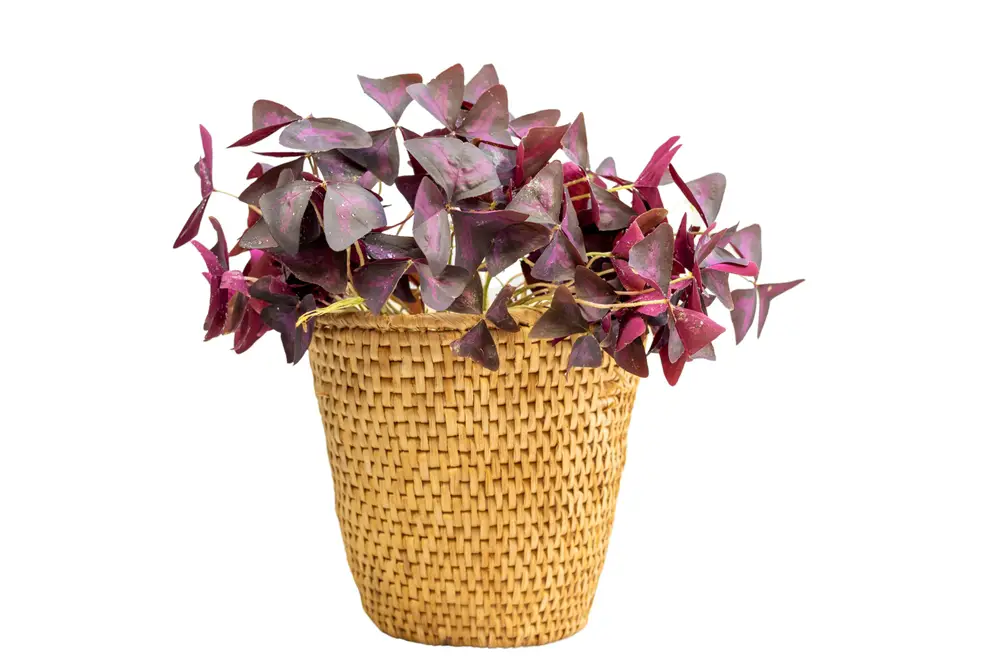
Shamrock plants, also known as Oxalis, are a popular indoor plant due to their easy maintenance and attractive foliage. However, like any plant, they can experience issues that may cause them to droop or wilt. In this section, we will cover some of the potential issues that may cause a shamrock plant to droop.
Disease
One of the most common issues that can cause a shamrock plant to droop is disease. Fungal and bacterial infections can cause the leaves to turn yellow or brown, and the plant may begin to wilt. Some common diseases that can affect shamrock plants include:
- Root rot: This is caused by overwatering or poor drainage, which can lead to the roots becoming waterlogged and rotting.
- Powdery mildew: This is a fungal infection that can cause a white powdery coating to appear on the leaves.
- Bacterial leaf spot: This is a bacterial infection that can cause dark spots to appear on the leaves.
If you suspect that your shamrock plant may be suffering from a disease, it is important to take action quickly to prevent it from spreading. Remove any affected leaves and treat the plant with a fungicide or bactericide.
Yellowing Leaves and Stunted Growth
Another issue that can cause a shamrock plant to droop is yellowing leaves and stunted growth. This can be caused by a variety of factors, including:
- Lack of light: Shamrock plants require bright, indirect light to thrive. If they are not getting enough light, the leaves may turn yellow and the plant may become stunted.
- Overwatering: Overwatering can cause the roots to become waterlogged, which can lead to yellowing leaves and stunted growth.
- Underwatering: On the other hand, underwatering can also cause the leaves to turn yellow and the plant to become stunted.
To prevent yellowing leaves and stunted growth, make sure your shamrock plant is getting enough light and water. Water the plant only when the top inch of soil is dry.
Brown Leaves
Brown leaves are another issue that can cause a shamrock plant to droop. This can be caused by a variety of factors, including:
- Overfertilization: Too much fertilizer can cause the leaves to turn brown and the plant to become droopy.
- Low humidity: Shamrock plants prefer high humidity, and low humidity can cause the leaves to turn brown and crispy.
- Pests: Spider mites and mealybugs are common pests that can cause the leaves to turn brown and fall off.
Shamrock Plants and Pets
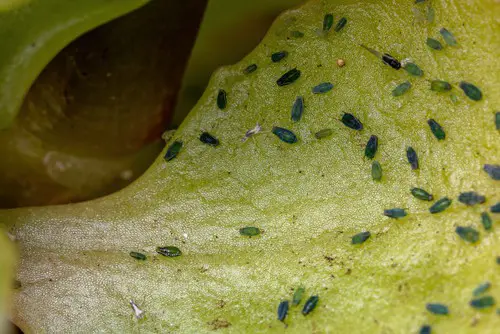
Shamrock plants are a popular houseplant, but pet owners may wonder if they are safe to have around their furry friends. While shamrock plants are not toxic to pets, they can still cause some issues if ingested.
Potential Risks
Shamrock plants contain oxalates, which can cause irritation to the mouth and digestive tract if ingested. This can lead to symptoms such as drooling, vomiting, and diarrhea in pets. Ingesting large amounts of shamrock plants can also lead to more serious issues such as difficulty breathing and kidney failure.
Prevention
To prevent any issues, it is best to keep shamrock plants out of reach of pets. This can be done by placing them on high shelves or in rooms that pets do not have access to. If pets do come into contact with shamrock plants, it is important to monitor them for any symptoms and contact a veterinarian if any issues arise.
Alternatives
If pet owners are concerned about having shamrock plants in their home, there are plenty of pet-friendly houseplants to choose from. Some examples include spider plants, Boston ferns, and African violets. These plants are not only safe for pets, but they also provide a pop of greenery to any living space.
Future Care for Shamrock Plants
Shamrock plants are a perennial plant that can live for many years with proper care. Here are some tips for future care of shamrock plants to keep them healthy and thriving.
1. Bulbs
Shamrock plants grow from bulbs, which are underground storage structures that store nutrients for the plant. After the plant has finished flowering, the foliage will begin to die back. At this point, the bulbs can be dug up, cleaned off, and stored in a cool, dry place until it’s time to plant them again.
2. Planting
Shamrock plants prefer well-draining soil and should be planted in a container with drainage holes. When planting, make sure to bury the bulb just below the soil surface. Water the plant thoroughly after planting, but be careful not to overwater.
3. Houseplants
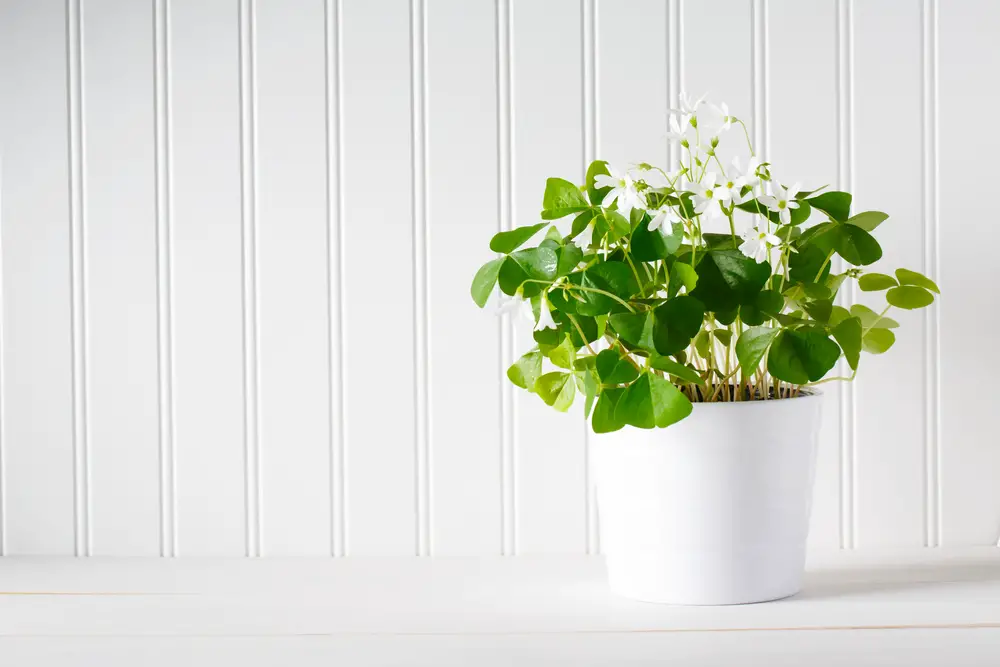
Shamrock plants make great houseplants and can be kept indoors year-round. They prefer bright, indirect light and should be kept away from direct sunlight, which can scorch their leaves. During the winter months, when indoor air tends to be dry, mist the leaves of the plant occasionally to help increase humidity.
4. Indoor Plant
Shamrock plants are a great indoor plant and can be grown in a variety of containers, from small pots to larger containers. They prefer to be slightly crowded, so don’t be afraid to plant them in a smaller container. When watering, make sure to water thoroughly, but allow the soil to dry out slightly between waterings.
5. Perennial
Shamrock plants are a perennial plant, which means they will come back year after year if given the proper care. In the fall, after the foliage has died back, the bulbs can be dug up and stored until it’s time to plant them again in the spring.
6. West
Shamrock plants prefer cooler temperatures and will do best in a west-facing window, where they can get bright, indirect light without being exposed to direct sunlight. If the plant begins to droop or wilt, it may be getting too much direct sunlight and should be moved to a cooler, shadier location.
Frequently Asked Questions
When do oxalis go dormant?
Oxalis plants, also known as shamrocks, typically go dormant during the summer months. This is a natural part of their growth cycle and should not be a cause for concern.
During this time, the plant will stop producing new leaves and may even lose some of its existing foliage. To help your oxalis plant through its dormant period, reduce watering and allow the soil to dry out slightly between waterings.
Shamrock plant problems and solutions
Shamrock plants can experience a variety of problems, including drooping leaves, yellowing foliage, and root rot. These issues can be caused by overwatering, underwatering, insufficient light, or the use of improper soil.
To solve these problems, it is important to identify the root cause and take appropriate action. For example, if your shamrock plant is drooping, it may be due to overwatering, in which case you should reduce watering and allow the soil to dry out between waterings.
Shamrock plant dormancy period
Shamrock plants typically go dormant during the summer months, during which time they may stop producing new leaves and lose some of their existing foliage. This is a natural part of their growth cycle and should not be a cause for concern.
To help your shamrock plant through its dormant period, reduce watering and allow the soil to dry out slightly between waterings.
Tips for caring for a shamrock plant
To care for a shamrock plant, it is important to provide it with the right amount of water, light, and nutrients. Shamrock plants prefer bright, indirect light and well-draining soil.
They also prefer to be kept slightly moist, but not overly wet. To promote healthy growth, fertilize your shamrock plant once a month during the growing season.
How to care for a shamrock plant outdoors
Shamrock plants can be grown outdoors in areas with mild climates. To care for a shamrock plant outdoors, plant it in well-draining soil and provide it with bright, indirect light. Water it regularly, but be careful not to overwater. In colder climates, it may be necessary to bring the plant indoors during the winter months.
Why is my shamrock plant wilting?
A shamrock plant may wilt due to a variety of reasons, including overwatering, underwatering, insufficient light, or root rot. To solve this problem, it is important to identify the root cause and take appropriate action.
For example, if your shamrock plant is wilting due to overwatering, reduce watering and allow the soil to dry out between waterings.

Hey, I’m Lisa and I’ve been an avid gardener for over 30 years. I love writing, talking and living in the garden! Feel free to connect with me on my socials below

